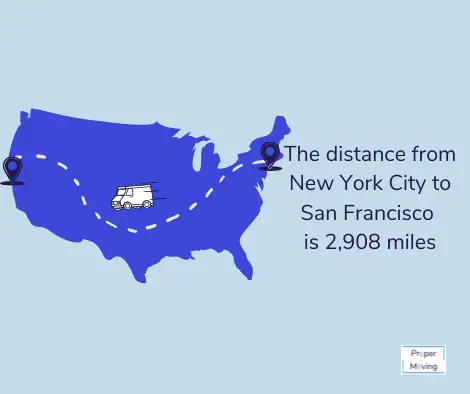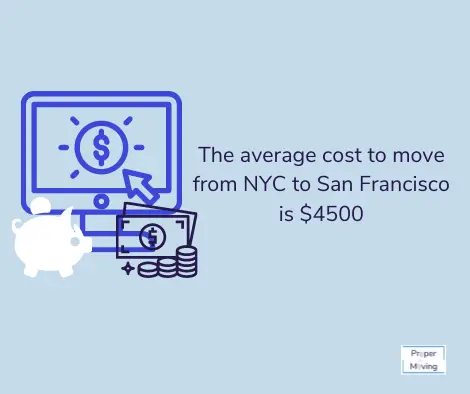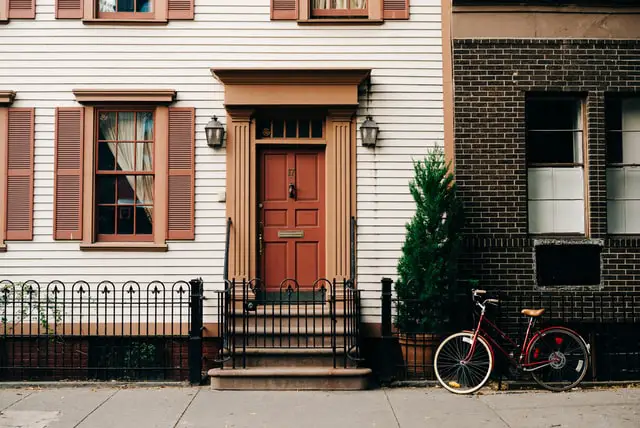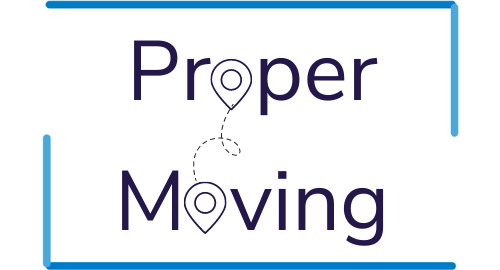Moving from New York City to San Francisco is a common move for lots of people, because of the similarities this pair of cities share.
They’re both thriving cities with booming economies and both cities attract a diverse mix of people. These similarities may help you to adapt to life in San Francisco much faster, but you must bear in mind that life in SF is a little more laid back.
So if you plan on trading in the Big Apple for the City by the Bay, this guide will explain the moving process and share some helpful tips to assist you with your relocation.
The Moving Process From New York City to San Francisco
How Far is San Francisco from New York City?
The distance between New York City and San Francisco is 2,908 miles. The driving time of this journey is approximately 44 hours by car depending on traffic.

It’s definitely worth noting that it’s an extremely lengthy drive, so a DIY move in a rented moving van is probably not possible. Hiring a professional coast-to-coast mover is probably the most viable option.
The flight time is roughly 6 hours and 10 minutes long, so if the idea of driving a car for 44+ hours doesn’t sound like fun to you, you definitely should consider flying.
What is the Average Cost to Move From New York City to San Francisco?
The average cost to move from New York City to San Francisco is between $2,500-$6,500. That means on average it costs roughly $4500.

There are many variables that determine the exact cost of a move from New York City to San Francisco such as the dates of the move, the number of items being moved, whether you’ll want additional packing and unpacking services, and whether you plan to do it yourself or hire professional moving services to do it for you.
Should I Move From New York City to San Francisco?
This move might not be a massive change for some people, but there are some definite benefits. Job opportunities from nearby Silicon Valley and a friendlier, slower pace of life are two of the biggest benefits. If this sounds good to you, then you should move from New York City to San Francisco.
How New York City Compares to San Francisco
Living Costs Compared
The first thing a New Yorker will notice when they arrive in San Francisco is that things cost more.
It’s no secret that San Francisco is becoming one of the most expensive places to live in the US, as there has been a massive inflation of real estate and rental prices in San Francisco.
The median rent in New York City is around $2,850, while it’s around $4,128 in San Fran. Where you decide to live in the Bay Area can massively increase/decrease your rent.
If you’re planning to buy a house in San Francisco you won’t happy to hear that buying an apartment in San Fran is around 1.8 times more expensive than in NYC. The median sale price of a house in NYC is $705,407. In San Francisco, the median sale price is a whopping $1,263,813.
In general, the cost of living in NYC is actually 30.5% cheaper than in San Francisco. So expect more expensive utilities, groceries, and healthcare costs in San Fran too.
Another important thing to note here is that the salaries are a lot higher in San Francisco too, so naturally, this leads to an increase in the cost of living.
Public Transportation
The SFMTA (San Francisco Municipal Transportation Agency) is San Fran’s public transport system. It’s comprised of buses, Metro trains, streetcars, and the iconic San Francisco cable cars.
The BART (Bay Area Rapid Transit) is the subway system that connects the Bay Area.
Just like NYC, San Francisco is an extremely walkable city. The SFMTA are continually committed to building and maintaining a walkable city.
In New York City an unlimited subway card costs $127 per month and $2.75 per ride. In San Francisco, a monthly Muni card that includes the rides on the cable cars and the BART costs just $98 and a One-Way ticket costs $3.00.
Weather
Another change that one must adjust to in San Francisco is the weather. San Francisco boasts milder and warmer weather all year round.
The summers in New York are very hot and humid, and the average high is around 84℉. San Francisco’s summers are more pleasant and mild, with the average highs staying in the 70s.
If you hate the snow, you’re in luck because while New York gets around 25 inches of snow per year, San Francisco gets none! The coldest average monthly temperature in New York sits at around 27℉, while average lows in San Fran are around 46℉.
Moving From New York City to San Francisco DMV
When moving from NYC to San Francisco, please note that you will have to get a new driver’s license.
Within 10 days of becoming a resident in California, you must get your new driver’s license. And within 20 days of entry into California, you must register your vehicle in order to avoid fees.
To obtain a new driver’s license you must visit your nearest driver’s license office in person. If you need more information about what you will need to complete the process it can be found here.
Buying a home in San Francisco
As mentioned previously, buying a home in San Francisco is more expensive than buying a home in New York City. If you are still willing to buy instead of rent, these neighborhoods are the best to consider if looking to buy a home.
Golden Gate Heights
Are you looking for a residential district that’s peaceful and in a central location? Well, Golden Gate Heights is for you. Many of the homes here boast ocean views which is always a bonus!

The housing stock in this neighborhood is made up of single-family homes rather than condos. Because of this, the neighborhood feels more family-friendly and feels a lot less dense.
In addition to this, a single-family home generally holds its value during a downturn and appreciates faster during an upturn.
Diamond Heights
Diamond Heights was one of the first neighborhood redevelopment projects done by The San Francisco Planning and Urban Research in the 50s. It was intended to help redevelop areas on hills that worked with the topography, rather than against it.
Houses in this area suit a range of different budgets. The area is also rated as a safe neighborhood to live and there’s great access to public transportation. If you have a dog you’ll love this neighborhood as there are lot’s of dog parks to walk your dog/dogs in!
Inner Richmond
Are you a young professional looking for a laid-back neighborhood to purchase your first property in? Inner Richmond might be a great option for you! Inner Richmond is a sub-neighborhood in the Richmond District.
The other areas that make up the district are Lake Street, Central Richmond, and Outer Richmond.
The housing stock in the neighborhood is made up of a diverse mix of row cottages, cottages, and Edwardian style houses.
There’s a wide range of restaurants to choose from in the area. Inner Richmond has been dubbed as “second Chinatown”, so if you’re a fan of dim sum, you’ll love this neighborhood.
Selling Your Property in New York City
The first step when organizing to sell your property in NYC is obtaining the right realtor for you. In addition to this, you must consider what time of year is the best time to sell.
Depending on the time of year, housing prices can fluctuate by thousands of dollars. In New York, the best time to sell your home for a speedy transaction is June.
While July is the best month to sell your home for a better price. Either of these months will be a good time to sell your home.

You must figure out what your house is worth if you want to ensure a speedy and profitable sale. You must compare your home to the area’s market value to confidently price your home. If you’d prefer an in-depth market analysis ask an experienced real estate agent to do this for you.
The right realtor will advise you through the whole process and hopefully, they will relieve some of the stresses you may have about selling your home in NYC.
Finding a Job in San Francisco Before You Move There
The job market in San Francisco can be extremely promising if you are in the tech industry, but it’s not the only industry where there are job opportunities. If you are wondering where to start the job search, the following places may help;
City and County of San Francisco: Department of Human Resources
If you are looking for a job within the public, private, or nonprofit sectors, this is a great resource to find jobs in the City and County of San Francisco.
Indeed
No matter where you are based, Indeed is always a great place to find job listings. Make sure to use the tools to filter your search to certain areas in San Francisco. The good news is that there are always new job listings posted daily.
To see the current job listings available in San Francisco, click here
Word of Mouth
Do you know anyone living in the Bay Area? Why not try and ask them if they know anyone that’s looking to hire.
Moving From New York City to San Francisco Checklist
Use the following checklist to check what needs to be done before moving from the Big Apple to the City by the Bay.
At Least 4 to 6 Weeks Before the Move
– Organize a professional moving company.
– Let your health care physician, dentist, and other service providers know that you are moving.
– Order moving supplies or ask your moving company to provide them as an additional service
– It is a great idea to sell or donate your unwanted items. You can sell on Facebook Marketplace or Craigslist. Or you can donate them to the Salvation Army and they will pick items up at no charge.
– Begin packing; clearly mark boxes with a marker indicating which room they will be going into at delivery.
– You will need to make your change of address known to several different places, such as wherever you do your banking, the DMV, your workplace, any other financial institutions (such as credit card providers), the post office, your utility provider, and, saving the most important for last, your friends and family.
– Sort plane tickets if you’re planning to fly.
2 Weeks Prior to the Move
– It is imperative to clean and/or make needed repairs on your old home before moving out, since leaving your place an absolute mess may leave your security deposit in jeopardy.
– Because of the abundance of fragile items in your kitchen, you’ll want to pack these items away long in advance, with protective bubble wrap to ensure nothing gets broken in transit.
– You will also want to begin packing your things from bedrooms and bathrooms, except for your essential items that you will be using until you move.
– If necessary, you will want to arrange a babysitter for your kids and/or pets for parts of the move that you need to be able to focus and get things done.
A Couple of Days Before Your Move
– Clean up your home completely, double checking any cracks and crevices that may have your stuff hidden away.
– Unless your movers will do it for you, dissassemble your furniture to make your move a smoother process, and ensure to keep any screws, brackets, or other small items that are needed for reassembly. Pro tip: tape these smaller items in a bag to the bottom of the furniture.
– Print out the floor plan of your new home and have enough for the movers as well.
– You may want to hit the ATM before moving day, as you’ll need to have enough cash to tip your movers. Generally speaking, you’ll want to tip $20-$30 per mover.
– Make sure that you confirm with your movers the details of your move. The last thing that you want is to have moving day come around, and you and your movers aren’t on the same page.
– Get in touch with the landlord or current homeowner of your new place, and ensure that you’ll be able to get the keys to your new place when you arrive.
– Document the condition of your old place through pictures and videos, to ensure that you have proof of its state. This will come in handy if your landlord tries to keep your deposit, based on incorrect facts.
Moving Day
– Hand over your old home’s keys to the necessary people, such as landlord or building management.
– Do a quick run-through of your home to ensure that nothing gets left behind, whether it’s just a smaller item, or an entire box of stuff.
– Ensure that everything you packed up is in your new home before unpacking everything.
– If the moving company you are working with is going to assemble your furniture, make sure that they reassemble it in the correct room to avoid unnecessary work.
– Be sure to thank everyone helping you move, and leave them a tip!
You did it! Congrats and enjoy your new home!


Recent Comments